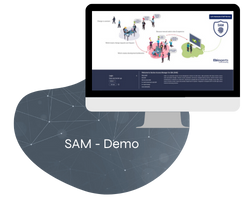SAM Launched
We here at Ebiexperts are very excited to launch Section Access Manager for Qlik (SAM) today 6 September 2021.
It has been a minute since we have launched a new product and we are ecstatic with this initial fully automated release of SAM.
SAM Automates Qlik Section Access

Churn is a constant!
It’s estimated companies churn 52% per annum in the USA, 22% in/out and 30% internal role changes within organizations which leads to quite a lot of time to manage data security on an application and user level.
Qlik Section Access (SA) is a very code based and manual method to manage security, users and access to data within Qlik applications. Qlik SA is generally managed as code within some protected sheets or writeback table type solutions. These solutions are very manual and static to manage and sometime complex to understand.
As change is constant and user churn is a reality this work, generally performed by developers, soon become very expensive to maintain. Developer’s time is better utilized developing and Section Access work is seen as maintenance thus not always the first thing developers attend to which impacts time to insights.
Since Section Access is seldom self-service it still requires a business stakeholder, possibly a service desk agent and a developer to attend to one person joining or leaving a business unit or the company. These people generally have access to multiple application thus compounding the work required per change event having to change the SA in multiple applications.
The challenge with SA is security and application logic changes and so does user access methods and reduction logic. Section Access is static in a way but can and does change with every change event and when you have data reductions these changes take more time and requires more testing.
Section Access Manager for Qlik
SAM automates Section Access across all your Qlik Sense Servers, Streams, Apps, Users and Data.
SAM synchronizes all changes and bringing them to a visual easy to use No-code interface where business people can manage their own access to the data without requiring the support of a developer.
SAM automates SA in three ways:
Auto: Auto mode is a 1:1 with QMC thus any QMC changes will automatically change the SA within the App. This method ingests SA across all your Apps automatically should they not have any SA script within them already.
Manual: Should you have SA scripts implemented with reduction and omit values SAM will reverse engineer them into the visual interface and enable the user to manage any changes by automatically synchronizing and scanning the Apps.
Unmanaged: Means you don’t wish SAM to manage the App i.e. you have SA in the App and you wish to keep it or you don’t wish to have SA in the App and pay for a SAM license for the SA. Unmanaged thus means SAM does not connect to the App.
Bit of History & SAM Future
We planned SAM in 2015 and finalized our specification for the product in 2016 but our long term strategy required we prepare WIP for SAM. We have done this and WIP is a fully fledged source control and version management solution today ready to integrate with SAM.
We have already planned a phase two and three release for SAM within the next six months where we will further automate SAM with algorithms and integrate both SAM and WIP with Qlik SaaS.
View Demo




